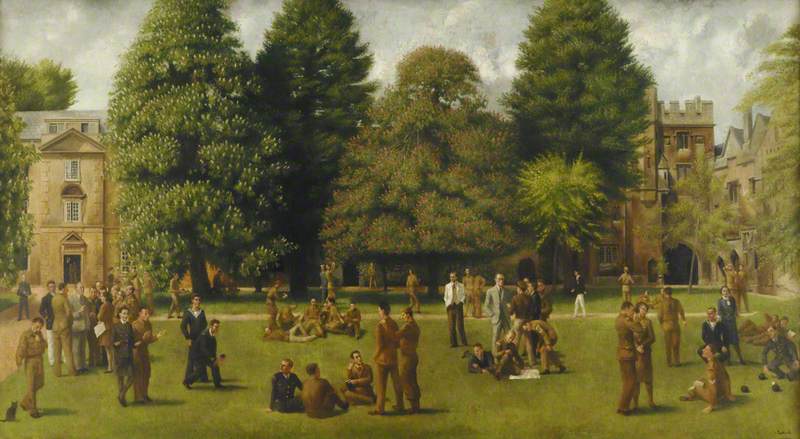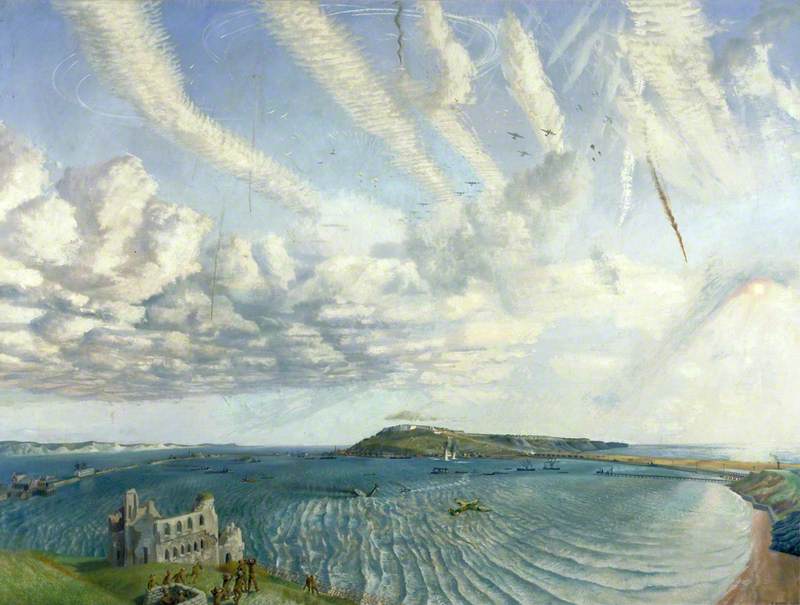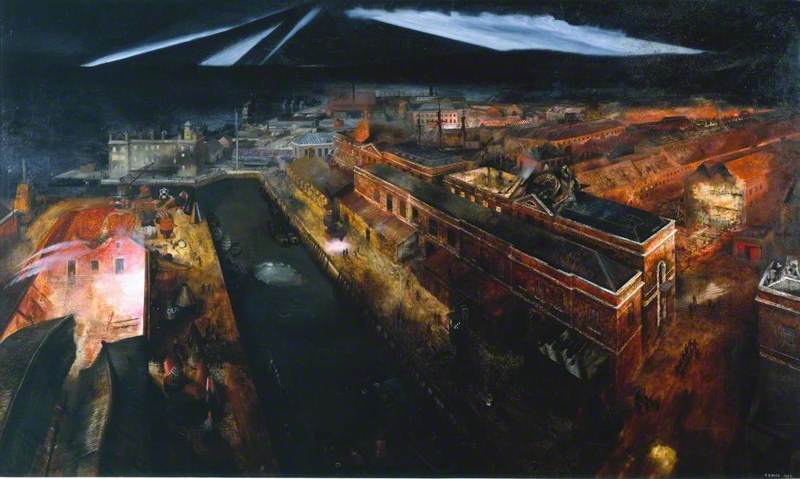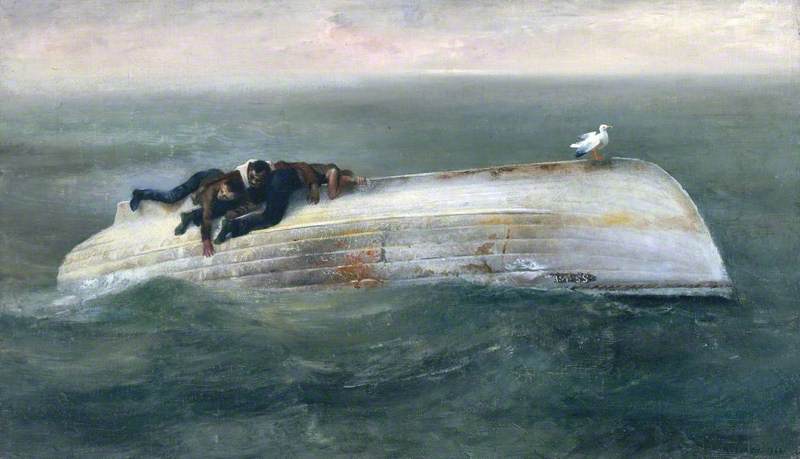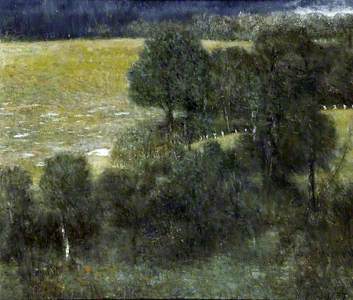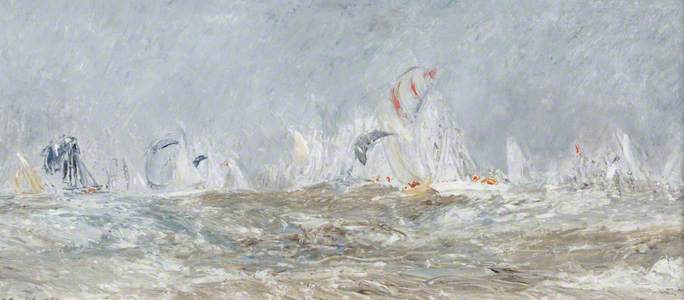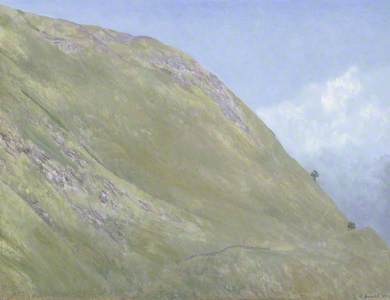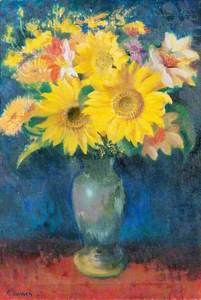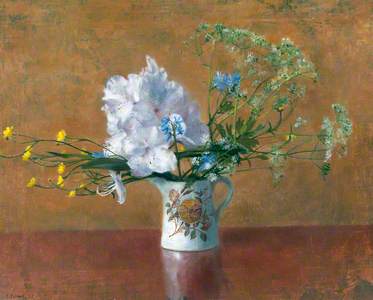I first met Richard Eurich (1903–1992) in 1989 when I proposed an interview with him for The Artist's & Illustrator's Magazine.
I'd seen his work in various exhibitions at the Fine Art Society, his dealers then, and admired not just his command of paint and strength of image, but the unexpected poetry his paintings radiated. There was a painting of two young people in a bathroom that was wonderfully innocent but also sexy, and his landscapes had all the mystery of distance and the close-up particularity of experience (see, for instance, The Watercourse, Gordale, 1949, Quarry Remembered, 1964, and Hillside in Wales, 1967).
Ironically he was best known then for his war paintings: extraordinary renditions of conflict at sea and in the air, accurately researched and re-imagined though not experienced at first-hand. Some war artists sacrificed accuracy of record to dramatic effect (Graham Sutherland and Henry Moore might be included in this category), but Eurich's skill in sorting out the essential from the non-essential and his gift of bringing clarity to a chaotic or complex theme never compromised the truth.
His great painting Withdrawal from Dunkirk, June 1940, now in the National Maritime Museum, is a superb example of this. Note the great thunderhead of smoke which dominates the painting, and the way the rescuing boats (from paddle steamer to Thames barge) are busily deployed in sharp contrast to the anxious calm of the tiny groups of waiting figures.
Eurich's ability to envisage a battle scene from a high viewpoint was unequalled, as Air Fight Over Portland, 1940, and Attack on a Convoy Seen from the Air, 1941, succinctly demonstrate.

Image credit: Bridgeman Images
Attack on a Convoy Seen from the Air 1941
Richard Ernst Eurich (1903–1992)
IWM (Imperial War Museums)His prowess at rendering a dramatic event in a thrilling way is particularly evident in Night Raid on Portsmouth Docks, 1941, in which HMS Victory, Nelson's flagship at the Battle of Trafalgar in 1805, is placed at the centre of the composition to remind viewers of England's glorious naval tradition. Protected from fire by the stout walls of warehouses, it is almost invisible but remains the secret heart of the painting.
Meanwhile, Eurich's adroitness at dealing with the human factor can be seen in the highly memorable Survivors from a Torpedoed Ship, 1942, based on a real incident. Here a black sailor helps two other survivors to cling to the upturned hull of the lifeboat. Tragically, he himself did not survive, though the other two sailors did. Winston Churchill thought that this was one of the finest paintings to come out of the war.
A Yorkshireman from Bradford, Eurich had studied art at Bradford Art School before going to London to take up a place at the Slade School of Art. 'I think it was the look of Bradford that made me want to paint,' he said. 'The mills and the steep streets were so beautiful.'
At the Slade he concentrated on drawing, developing a tough but sensitive and highly detailed sculptural style. His first exhibition, in 1929, was just of drawings, and he always said he subsequently taught himself to paint. 'My gods were not the Slade's gods', he told me in 1989. 'Gaudier-Brzeska, whom I liked very much, was absolutely unknown. Turner had become one of my gods, but he was very much frowned upon at the Slade. He was very unpopular indeed. I also used to go at lunchtimes down Gower Street to the British Museum. The Hellenic sculptures, like the Elgin marbles, were very wonderful, but I thought the Indian Museum was very much better, it had something which I wanted.'
Eurich's self-portrait of 1938, depicting him serious-eyed and determined, with a pipe in his mouth, was bought by another Bradfordian pipe-smoker, the writer J. B. Priestley, who later gave it to Bradford Art Gallery. After the war, Eurich did some teaching at art schools such as Camberwell and the Royal Academy Schools and continued to paint a whole range of subjects, from his celebrated 'Paintings for Children' series (many involving animals and games of different sorts) to landscapes and fantasy.
Among the fantasy pictures were the scarecrow paintings, inspired by such stories as Worzel Gummidge, a good example of which is Men of Straw, 1957. The two paintings of The Mummers, 1951 and 1952, are typical of this half-real, half-imagined world, where magic and fancy take precedence over the everyday.
In my interview with him, Eurich spoke of the artists he admired. 'I think Stanley Spencer's drawings are absolutely beautiful. Constable is very fine. I like the small things that Turner did at Petworth. He produced far too much: one has to select certain things. I do like his sketches, I like them more and more.'

© the artist's estate / Bridgeman Images. Image credit: Bradford Museums and Galleries
Robing Bathers on a Rainy Beach 1969
Richard Ernst Eurich (1903–1992)
Bradford Museums and GalleriesPaul Nash was another of his heroes, but he said that he discovered Bruegel and Piero della Francesca rather late in life. The influence of the latter can be seen in the magnificent late painting Robing Bathers on a Rainy Beach, 1969, the painting featured on the cover of my new book.
For it is the sea that remained Eurich's favourite subject. In 1989, he admitted to me: 'I don't like travelling at all. The view from this window is as much as I need. I get a sort of visual indigestion if I travel.'
He was still painting Yorkshire from memory, and the occasional still-life, but his main theme was the business of the beach and the shipping in the Solent near his home at Dibden Purlieu, in the New Forest, Hampshire. He painted the New Forest, for example, the work Forest Trees, 1987.
Of his very early paintings of ships and the sea, some of them done before he'd ever been taken to the seaside, he said: 'The sea was in my imagination. I've always loved it.'
He continued to paint and draw the Solent in all weathers and all moods – the changing skies and mysterious sea, the ships – until the end of his life. Two late works show very different approaches to an endless subject: the highly worked drawing Figures on a Beach – The Rainbow, 1975, and the dynamic, loosely painted Yachts in a Squall, 1980. Both are evocative and beautiful pictures.

© the artist's estate / Bridgeman Images. Image credit: The Ingram Collection of Modern British and Contemporary Art
Figures on a Beach – The Rainbow 1975
Richard Ernst Eurich (1903–1992)
The Ingram Collection of Modern British and Contemporary Art
I saw Eurich one last time: at the press view of his superb 1991 exhibition 'From Dunkirk to D-Day' at the Imperial War Museum. Here were gathered his finest war paintings and they made a deeply impressive display. There was no chance for a proper conversation — Eurich's deafness precluded that — but I was able to tell him how much I admired the paintings on show.
Since then, my admiration has deepened, together with my understanding of his aims and intentions. The research for my monograph on Richard Eurich, published by Lund Humphries, has only sharpened my appreciation of his skills and his vision. No mere realist, Richard Eurich was a visionary whose best work has a haunting intensity. He made images to last, as this new look at the range of his output proves. A master of modern British painting is here revealed, far more varied and experimental than even the knowledgable had guessed.
Andrew Lambirth, writer and author of The Art of Richard Eurich







